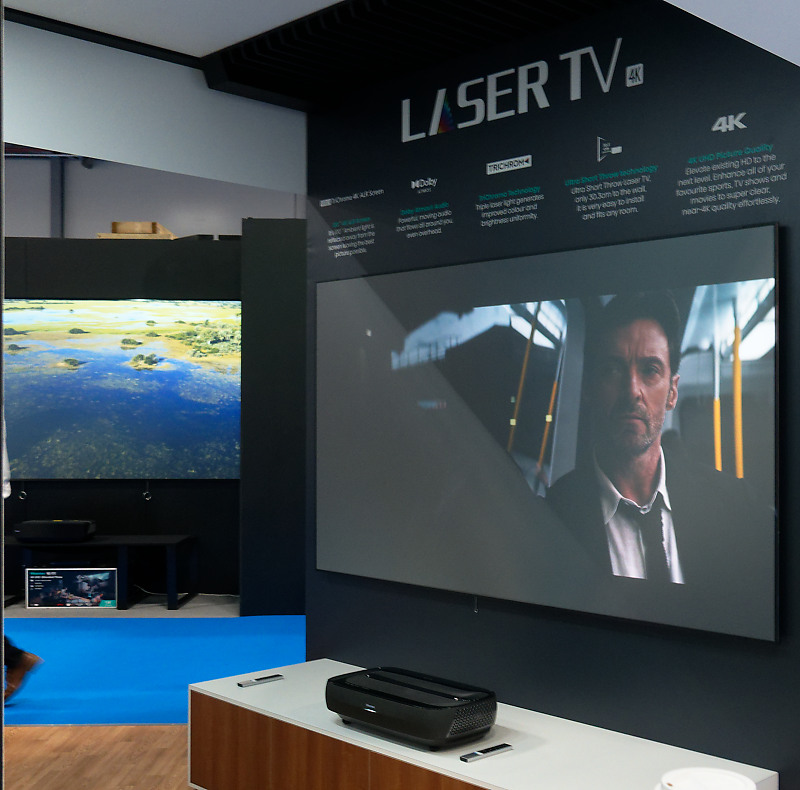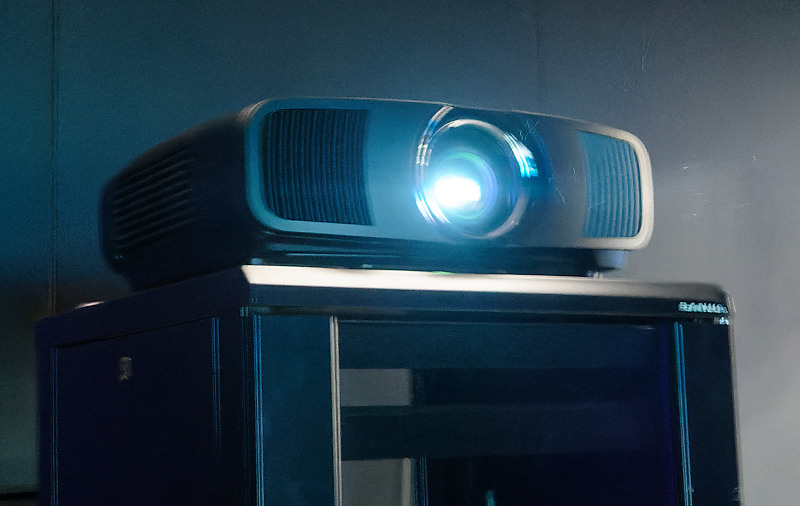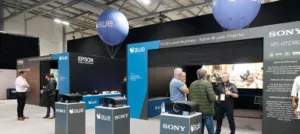The show was quiet. Given Covid and the problems with fuel, that really was not surprising. Either of those issues would have been a challenge for the organisers, but the combination made it very difficult. The lack of visitor numbers did mean that I had a chance to spend more time than I expected with each of the display specialists, although there were only a few of those among the 60+ exhibiting companies. Most were promoting home automation and signal distribution, it seemed.
Still, AWE Europe, a distributor that concentrates on the CI market (and not to be confused AWE Expo that is an event about AR & VR in Munich) had a large booth with support from brands that it supplies including Sony and Epson.
I started off by talking to Hisense which was at the show to demonstrate and promote its ‘Laser TV’ products. By one of those quirks of ‘synchronicity’, that very morning, I had been writing about a new offer by the firm’s US subsidiary to consumers of a 100 day money back warranty. I asked if the UK or European businesses were going to adopt this policy, but at the moment there is no plan to do so. There is obviously some financial risk to such a project and in the US the move is part of a multi-phase marketing strategic plan that involves a lot of investment.
Turning to the products, there were several units on show using both laser phosphor and RGB laser + laser phosphor technology combined with DLP imagers. The firm is currently using the APLD 4.0 technology for the RGB + LP category. That technology was first developed in 2018 by Appotronics, so we’re getting close to APLD 5.0. Like Appotronics, the firm quotes 106% of Rec.2020 as colour coverage.
That’s an impressive number, but I’m not able to get my head around the concept. The point of Rec. 2020 is that the primaries are on the spectral locus, at the limits of human vision. That means, surely, that the only way to create a chromaticity range of more than 100% of Rec.2020 is to move the wavelength of the primaries? That surely means that some of the Rec. 2020 triangle must be missing? If any reader can explain to me how you can have more than 100% coverage of Rec.2020, I’d be happy to hear it! (I do understand that you could cover a different range of colours with a bigger area, without covering all of it). Staff at the booth couldn’t clarify it for me.
 The display on the right is the 100″ with the fresnel lens – the rear one the zero gain flexible 120″ version.
The display on the right is the 100″ with the fresnel lens – the rear one the zero gain flexible 120″ version.
Anyway, the laser TVs were shown in the 100″ and 120″ versions which are both supplied with special ALR screens. The 100″ uses a rigid screen based on fresnel technology and staff used smartphone’s LED to show the reaction to light coming from different directions. Initially, I found the obvious hot spot slightly disconcerting, but moving to the optimum viewing position, the effect was mitigated and uniformity looked good. There is some gain from the screen so viewing from very wide angles is not great. However, the 120″ has a flexible screen that does not have gain and gives much more uniform off-axis performance. It is also the best solution when it is difficult to get a 100″ rigid screen into the home.
The ‘first worldwide showing’ that I saw was the new EH-LS11000W projector – a new 3LCD LP projector from Epson. The unit has UltraHD resolution with dual axis frame interpolation to create UltraHD images from FullHD LCD panels. The unit has a 2.1X lens with powered focus and shift and they are compatible with Calman calibration software. The unit produces 2,700 Ansi lumens and there is a black-cased version with 2,500 lumens of output. The white version lists in the UK at £4399 while the black one costs £4,099.
 Not the best photo I’ve taken! The new Epson looks like a projector.
Not the best photo I’ve taken! The new Epson looks like a projector.
The content being shown was not really suitable for guaging the resolution, but the bright highlights of saturated colours shown highlighted the ‘traditional’ virtue of three imager projectors of maintaining full colour volume. The new projector has colour coverage of over 85% of DCI-P3.
We had a chat with Sony, which was showing its OLED and LCD TVs as well as a demo of the Crystal LED system, although there was nothing new from what we saw at the Peerless event a couple of weeks ago. The Crystal LED can be purchased by CI firms for domestic use, but it is being marketed by Sony’s Professional division. The firm was showing its impressive VPL-GTZ 380 projector which uses native UltraHD 0.74″ SXRD imagers (with 100% of DCI-P3) and was announced a year ago. (Sony Launches New Native 4K Home Cinema Projectors, Featuring Advanced Processing and HDR Enhancement)
Finally, we had a look at some interesting HDBaseT-based stackable matrix systems that are supported by software that also operates Philips Hue and Hako lighting. Up to 32 channels can be supported and the firm believes it is easier to support and use than AV over IP at the moment. (BR)



